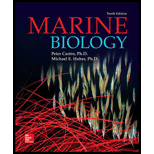
Concept explainers
There are marked differences in the type of organisms found at four different locations at the same tidal height along a rocky shore. What might account for this? Offer at least three possible explanations.
To mention: The three possible explanations on the account for marked differences in the type of organisms found at four different locations at the same tidal height along a rocky shore.
Introduction: Rocky shores are the shores that are made from solid rock formed at the intertidal coastal area. Epifauna are the animals that live on the surface of rock or sand or even other organisms. The organisms that inhabits in the rocky intertidal area are fully exposed to the elements and experience a physical stress due to the exposure.
Explanation of Solution
Rocky shores can be characterized as a habitat to some of the most biologically diverse communities that are present throughout the world. As the ecosystem lies at the interface of sea and land, it exposes the organisms to the terrestrial and marine habitats alternately in rhythm with the tidal cycle. The organisms that are found in different locations of the rocky shore may vary and the marked differences may be due to the reasons as follows:
Physical factors: The physical factors may change the appearance and adaptations of the organisms living along the rocky shores. The physical factors are as follows:
- Exposure to the wave action: Locations on the rocky shore have different types of wave action including high, low, and moderate waves and the organisms living on such area have difference in their adaptation and appearances.
- The type of rocky substrate: Rocky substrate to which the organisms are struck varies in terms of stability, color, and other particulars.
- Relative exposure to light.
- Abrasion by sand due to proximity to a sandy shore.
- Presence of seeping fresh water and pollutants.
Biotic factors: In addition to the physical factors, there are some biotic or biological factors which are as follows:
- Food
- Predation
- Competition for the space
Want to see more full solutions like this?
Chapter 11 Solutions
Marine Biology (Botany, Zoology, Ecology and Evolution)
- To explain the sedimentation of waste harming the coral reefs.arrow_forwardDescribe at least one adaptation that allows a) planktonic organisms such as diatoms or jellyfish to stay in the photo zone (where light penetrates the water), and b) marine birds to thrive in the salt marsh/tidal environment.arrow_forwardDescribe the physical, chemical and biological limitations for those available microhabitats. Relate ecological concepts to micro scale. Recognize that the types of interactions that occur between macroscopic organisms can also occur on the microscopic scale. Give examples of predations, mutualism, neutralism, and antagonism in the microscopic world. Distinguish between mutualism and synergism. Distinguish between predation and parasitism. Describe the steps in biofilm formation. Describe how quorum sensing is involved in biofilm formation Describe how microbial populations interact within a living biofilmand describe the advantages to living in a biofilm and the genetic changes that occur in cells that adopt this lifestyle.arrow_forward
- Plasmodium is a vector for mosquitos. It is a protozoan that is the causal agent of malaria, which is responsible for killing as many 855,000 people in 2013, the majority of them being children. Populations of mosquitos are strongly influenced by the availability of standing water for egg-laying and larval development. How might mosquito density, and thereby human mortality, be affected by patterns of rainfall?arrow_forwardSpecifically, what kinds of organisms are most important in deposition of calcium carbonate on coral reefs?arrow_forwardWhy was there an outbreak of “Red Tide” in the ocean water surrounding Minamata city in the 1950’s?arrow_forward
- Based on the graphs and Using the data from the two experiments, choose the interaction between species in the interaction diagram above.arrow_forwardThe graphs show how the cloudiness of the water at two different sites varied over a period of one year. Site A had a low nitrate concentration. Site B had a high nitrate concentration. (i) Describe and explain the effect of increased nitrate concentration on algal growth. (ii) Algae do not live long. Explain why the presence of large numbers of algae results in a fall in the amount of oxygen dissolved in the water. (iii) There are very few submerged water plants at Site B. Use (iii) the graphs to suggest how placing a speed limit on boats might allow submerged water plants to become re-established at Site B.arrow_forwardExplain the "phosphate trap" in the estuary of Chesapeake Bay. Why was a local ban on phosphorus in detergents not particularly helpful in mitigating eutrophication in the estuary?arrow_forward
- Zones of marine organisms can usually be seen along rocky shores. How might tidal patterns result in this sort of differential growth?arrow_forwardA new study by Tel Aviv University researchers found that in a marine environment, microplastics absorb and concentrate toxic organic substances and thus increase their toxicity by a factor of 10, which may lead to a severe impact on human health. Name and discuss two (2) possible Ecology topics applicable on the recent findings stated.arrow_forwardA) Briefly describe any two (2) examples of how the environment/habitat can limit the movements of nektonic organisms, and please include the site where you found this information B) List 5 adaptations that nektonic organisms have to move independently of currents (note: you don't have to explain these, just list them)arrow_forward
